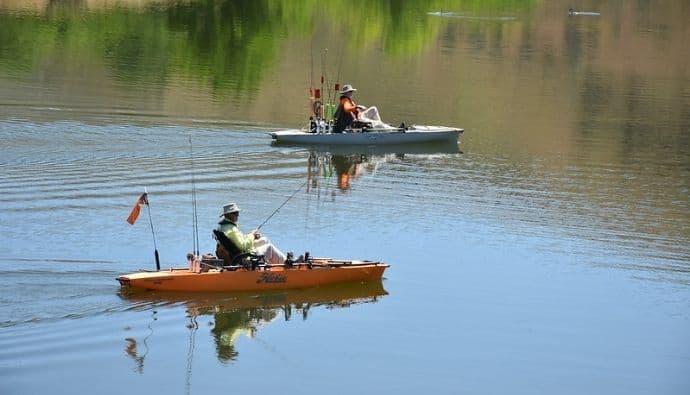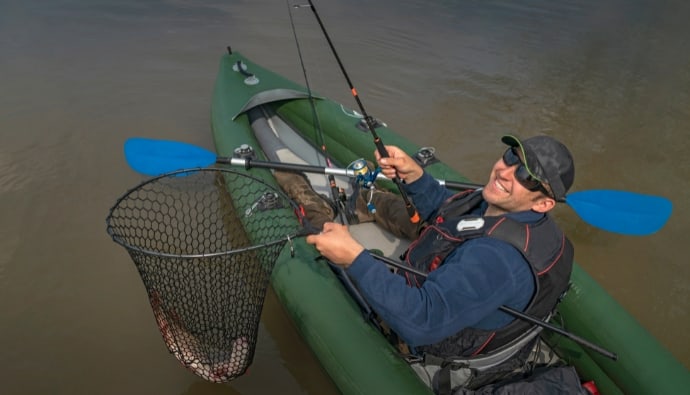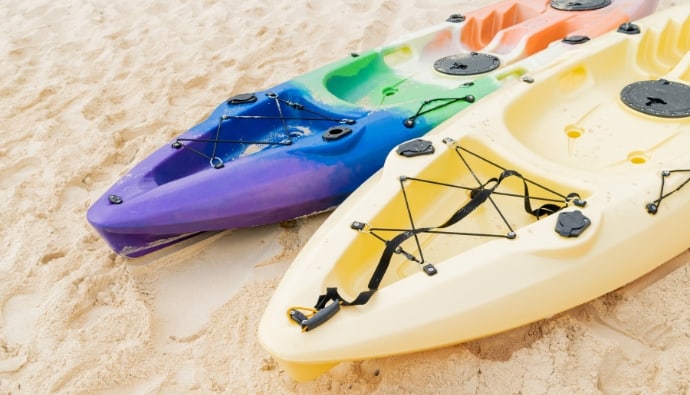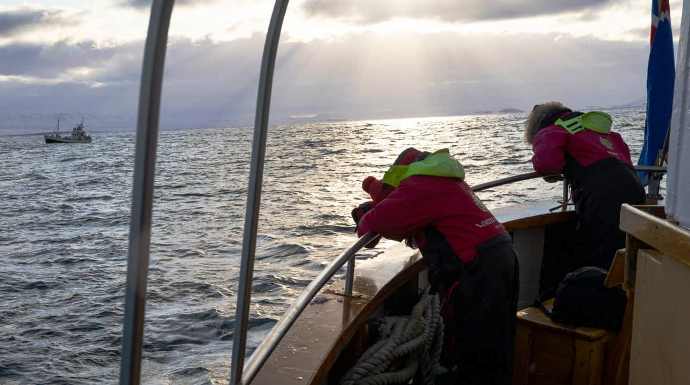Whether you’re a beginner or a professional angler, it’s best to be prepared and learn these freshwater kayak fishing tips to improve your fishing skills.
So without further ado, let’s dive in!

9 Freshwater Kayak Fishing Tips
Tip #1: Enhance Your Kayaking and Angling Skills
It’s important to know how to use your kayak as much as angling. Try and learn how to kayak and fish at the same time and practice it out.
Use your kayak on a peaceful lake and learn how far you can lean before you tip over. This will help you maneuver your kayak better.
Anglers are not blessed with having the best angling skills on the first try. That’s why you need the patience to practice and enhance your skills. Take note that there are bigger fish, like large bass, and many species that dwell in cold water.
Tip #2: Kayak Fishing in Lakes
Lakes are known to be great fishing spots. It is calmer than rivers and streams; therefore, freshwater kayak fishing can go smoothly here.
Get a bigger boat for bigger lakes, then smaller ones for small ponds. Kayaks can go to areas with thick Lilly pads and dense grass flats that other boats can’t get into.
The sit-on kayak is highly recommended for kayak fishing in lakes where you sit on top of the kayak. Sit-on models are known to be more accessible and comfortable.
However, you should get a bigger kayak if you’re planning on kayak fishing on bigger lakes.
But before buying, make sure you read fishing kayak reviews first to find the best kayak for you.
Tip #3: Kayak Fishing in Rivers and Streams
Kayak fishing in rivers and streams can be tricky if not equipped with the right kayak fishing accessories. Rivers and streams are fishing hotspots, but the current is the biggest hazard.
Don’t anchor your kayak unless you can harbor it properly. And avoid bringing too much gear.
The sit-in kayak is a top suggestion for kayak fishing in rivers and streams. With sit-in kayaks, you can gain greater control while paddling and lessen fatigue during long fishing trips.
Tip #4: Tips on Using Live Baits
Live baits are great for all sorts of fishing. The trick is to find out how to use and carry it easily. However, it can be a challenge to use live bait while fishing.
Don’t forget to bring a live bait container. Additionally, these containers can fit most kayak cup holders. A good piece of advice is to place minnows on a drop shot rig.
You should try and explore more while using live bait. Try using a live crayfish and catch large river walleyes, largemouth bass, and smallmouth bass.
You should try using single hook baits as much as possible and pinch barbs for quick hook removal.
Tip #5: Tips on Using Fish Finders
Nothing helps in catching fish more than having a kayak fish finder installed. Just make sure that it does not interfere with your casting or paddling.
This device lets you gain control of the overall sensitivity of the receiver. Whether the sonar image is gray or colored, the shading and color variations indicate the target density.
In certain fishing situations, a fish finder can help you catch a lot of fish. I advise learning what fish species look like on a fish finder.
Tip #6: Always Check the Weather
Checking the weather before fishing is just as important as checking you have all the equipment you need. The weather will surely affect your trip more than you know.
Strong winds can cause great waves and rock your boat. Also, rain can be uncomfortable for kayak fishing and can drown you in cold water. If there’s a chance of a thunderstorm, don’t push yourself to go kayak fishing.
Always check the weather reports first before you go to your fishing spot. And, for your safety, it’s better to come prepared for any weather conditions.
Tip #7: Fishing Kayaks Safety First
The first thing you should pack on a fishing trip is safety equipment. The life jacket is your kayak’s most important piece of equipment. It would be best if you never went on fishing trips without one.
The safety equipment you should have are a personal flotation device (PFD), knife, VHF radio, first aid, and signaling gadgets.
I propose always having a light post to be visible when you’re going fishing during nighttime. Another piece of safety equipment you should have is your paddle leash.
You use this so that you won’t lose the paddle if it falls into the water while fishing.
Tip #8: Equipment You Should Have on Your Kayak
Of course, you can’t go kayak fishing without the right equipment. Before venturing to fish hotspots, here’s what you should have on your kayak.
Equipment you should bring is fishing electronics (fishfinder), a bait bucket, fishing tools, kayak anchor systems, and storage for your fish.
Most new kayak models have this feature already, so take time to check which is the best for your fishing style.
Tip #9: How to Keep Your Tools, Tackles, and Gear within Reach
When freshwater kayak fishing, it’s important to have everything within reach to not make too much movement. You might make too much movement and accidentally tilt over. Install a rod holder if your kayak doesn’t have one.
Also, it is best to prepare the best tackle box for kayak fishing that includes: the best fish grips, measuring tape, stringer, hook remover, and reels (like the spinning reel).
You can also store small trays in your cargo pants or vests. I highly recommend investing in kayaks that have rod holders and can accommodate you and your equipment. Most kayaks these days are designed to have the best storage setup.
Conclusion
Many fishing opportunities are wasted because anglers have insufficient skills and don’t have the right equipment for fishing from a kayak.
By knowing these tips, you can be one step ahead of your fishing game. So practice well and learn more tips from other anglers to catch more fish!



 Facebook
Facebook YouTube
YouTube









